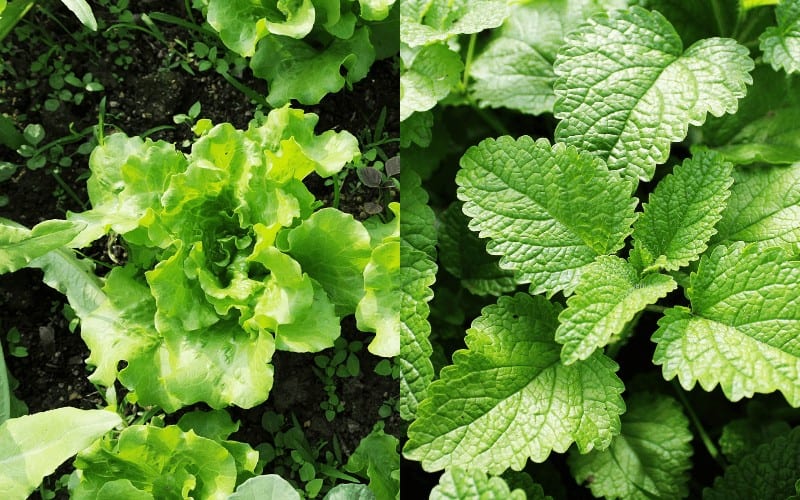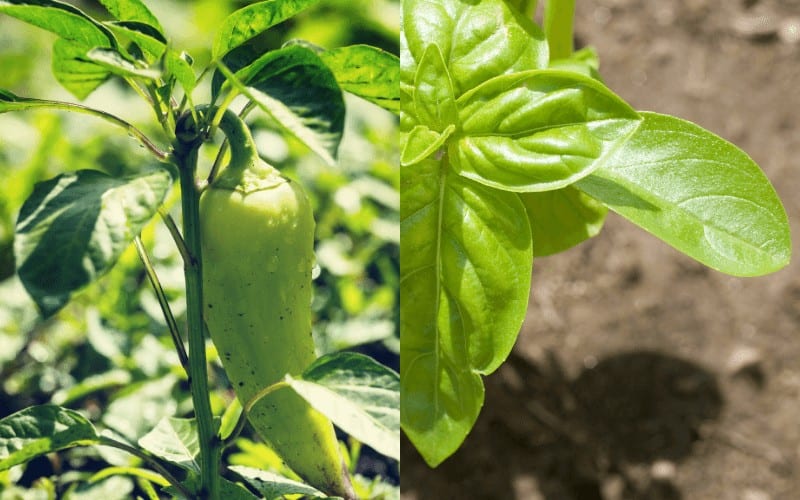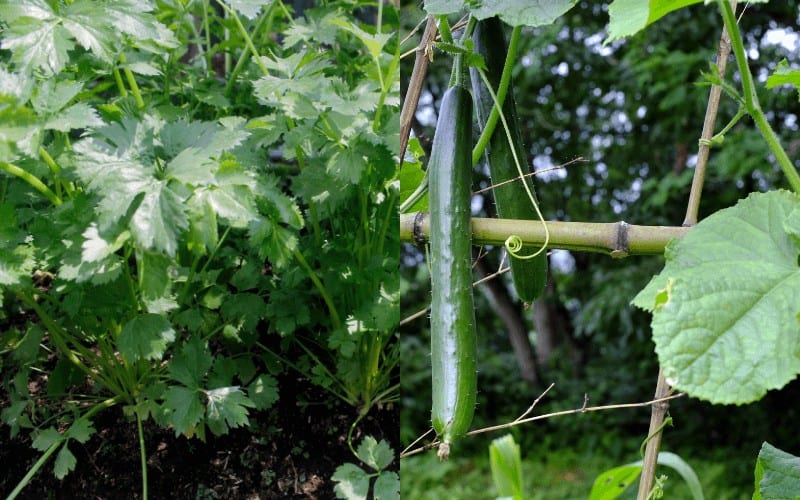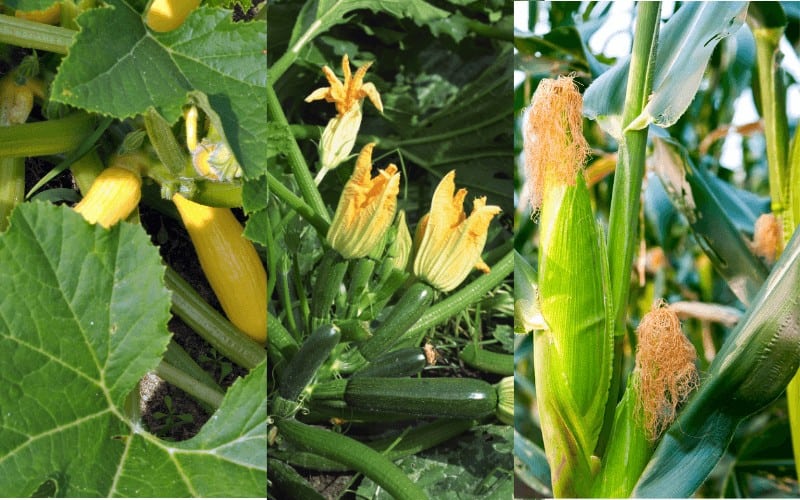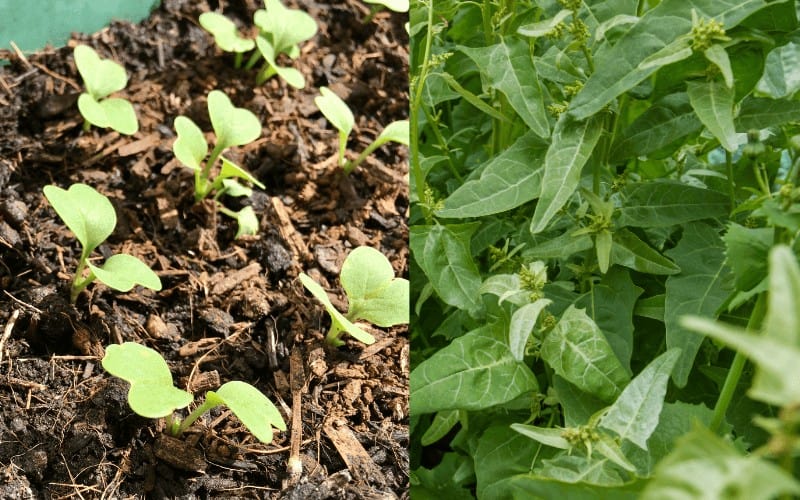It is no longer a new thing to see vegetables and herbs grow together. The method of planting these two together is known as companion planting.
The companion plant renders help by providing support or shade, gaining the attention of useful insects for pollination, discouraging pest activities, or providing nutrients.
Some of these companion plants can also enhance the health of the soil by trapping nitrogen. In this article, we would look at some vegetables and herbs that grow well together.
Table of Contents
Vegetables and Herbs That Grow Well Together
The following are examples of vegetables and herbs that grow well together, but What is companion planting? Companion planting is the use of a plant to support the wellbeing of another.
1. Lettuce and Mint
Lettuce is one of the essential vegetables that is used for making salads. It is leafy and goes well with mint. For this particular combination, plant the mint amid the lettuce. The mint smell has a way of keeping slugs off the leaves of the lettuce.
Snails and slugs love the young and tender lettuce, so they eat the leaves and seedlings even before it gets the chance to grow. Mint, however, will repel these snails and slugs and leave your lettuce productive.
2. Pepper and Basil
One would think that as hot and spicy pepper is, it would be free from pests' attack. But that is not the case. Pepper has pests. Examples of these pests are fruit fly, thrips, pepper weevil, pepper magot, corn earworm.
Basil is one of the plants that can be planted with the pepper. It enhances the flavor of the pepper. It also helps to keep away some pests like the aphids, flies, spider mites, mosquitoes, pepper maggot, pepper weevil, and white mice of the tropics.
3. Tomato and Basil
These two go together when you are making salads. They are all-weather friends. Tomato and basil are used together when making sauces. They are also planted together as companion plants. Basil helps tomatoes to increase yield and productivity.
It has a strong smell that floats on air. The scent is quite appealing to humans. But to some insects? Not so much.
Some of the pesticides used in controlling insect pests are made from extracts gotten from basil. The basil's smell repels many insects that may want to feed on the tomatoes in the garden.
Some of these insects are tomato hornworms, whiteflies, aphids, asparagus beetles, and houseflies. These insects have debilitating effects and need to be controlled. On the flip side, basil appeals to some insects that are important for pollination to tomatoes.
Lastly, tomato and basil planted together combine to give the tomato a fresher and better flavor. When you plant tomato and basil together, they both share the nutrients directly under the soil's surface.
This sharing improves tomato flavor because the flavor of fruits and plants comes from under that soil surface. The resultant tomato is one that is irresistibly rich and sweetened in taste.
5. Celery and Cucumber
Cucumber is one of those vegetables that can grow well even in sweltering weather conditions. Cucumber is of two types, the bush cucumber and the vining cucumber. The vining variety is famous for salads while the bush cucumber is used for pickles.
Celery is an edible herb that has a strong aroma. The aroma is offensive to some but appealing to others. Celery is one herb that can be used to grow cucumbers. The celery is vital in repelling pests that attack and feed on cucumber like the cucumber beetles.
Rabbits or deer sometimes can find their way to your garden and eat their way through your veggies. The smell of the celery will also help in keeping them far away from your vegetable. Celery beside or near your cucumber assures you of a pest-free and wholesome harvest.
The leaves of celery are quite attractive also to ladybugs and bees. These are insects that aid in pollination. The ladybug does not only help in pollination, but it also feeds on small aphids that are present and wreaking havoc in your garden.
6. Summer squash/Zucchini and Corn
Unlike previous combinations with one of the plants giving all the value, this combination is mutually beneficial to each other. The summer squash/zucchini have broad leaves and a vining nature. These two characteristics help to keep weeds at bay in the garden.
The leaves of the squash/zucchini are broad enough to provide shade and prevent sunlight from reaching weeds. And when the sun does not reach the weeds, they cannot grow. Weeds compete with plants for nutrients available in the soil and hence terrible news for your garden.
The leaves of the squash/zucchini are also vital in preventing moisture loss from the soil. This would leave enough moisture for other plants (the corn) to use for their growth. The zucchini/squash does not have leaves palatable to rodents and other larger animals that may want to feed on the corn.
They have spiny leaves that deter rodents. The corn, on its part, grows tall, taller than the squash. And since the squash is a vining plant, it needs the cornstalks to grow correctly.
Native Americans do not joke with this combo. They refer to them as 'gods gifts.' They are always planted and eaten together. It also makes sense to plant the squash and corn together since both have the same soil fertility requirements and moisture.
7. Carrot and Tomato
These two are fit to be planted together. They are planted in the fall and spring. The carrot is extremely sensitive to heat. At soil temperatures above 75 degrees, the carrot will not grow.
This is why carrots need to be planted with tomatoes. The tomatoes provide shade, so the carrot's soil does not become too hot for it.
This is necessary since the carrot is a root vegetable in which the edible part is underground. Not just that, tomatoes give off solanine, this chemical is a natural pesticide, and they are quite useful in repelling pests that trouble carrots. Some of these pests are moths, aster flies.
Carrots have their role to play too. They make sure the soul that surrounds the tomato roots is very aerated. This allows water and air to get through to the root properly.
8. Corn and Green bean
Corn and squash may seem like a match made in heaven, but corn and the green bean is an even more exciting combination. They are one of the most popular vegetables and herbs that grow well together.
The cornstalks are quite useful for the beans. The bean is a vining plant and, as such, needs a stalk to grow on.
Instead of sticking as a trellis for beans, plant an ear of corn instead for good measure. The beans' tendrils are so thin, and they cannot affect the growth of the corn in any way.
On the other hand, the beans, just like many legumes, have the uncanny ability to fix nitrogen. How is this possible? Bean have nodules in their roots that can trap atmospheric nitrogen and keep them in the soil.
The corn cannot do this trapping even though it needs the nitrogen more. So, the bean helps out with fixing nitrogen for the corn while the corn gives the beans structural support.
9. Radish and Spinach
Pronouncing 'radish and spinach' may sound like a poorly done rhyme but wait till you plant them together in the garden. Radish is quite popular in the garden, and there are lots of plants that can be used as its companion plant.
The first reason why radish is popular in the garden is that it is a fast grower. In just one week, radish has germinated. It is rooted in plants that grow slowly and also to mark rows in the garden.
Spinach grows slowly, and as such, it is hard to track when they are planted. When you plant radish with spinach, please take out the radish once it is done growing. This will let your spinach turn out bigger. So, instead of just planting spinach, you can add the quick radish for row marking.
After a few weeks, when the spinach is visible above the soil, take the radish out. The radish is not just for marking rows. The greens are entirely edible, have high fiber content and low calories.
Read Also:
- Exciting Blue Star Creeper Companion Plants
- Check Out These Turnip Companion Plants
- Best Sweet Potato Companion Plants
- Companion Plants For Watermelon
Conclusion
Companion planting is an exciting thing to do in the garden. This is not just because of the positive or auxiliary role these plants play for each other. There is more. It makes gardening and garden management relatively easy.
Again, they help to increase the yield of the plants in the garden. Companion planting can help the garden maximize the potentials in the soil. Some of these plants are shallow-rooted plants, and others are deep-rooted plants.
When this combination is done, the soil nutrients are appropriately utilized, and the harvest is doubled. There are many other examples of vegetables and herbs that grow well together, and finding which plant that grows well with your main plant is a wise option.

